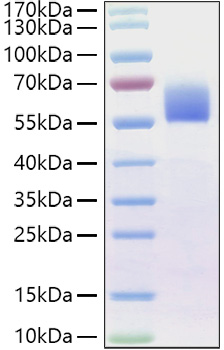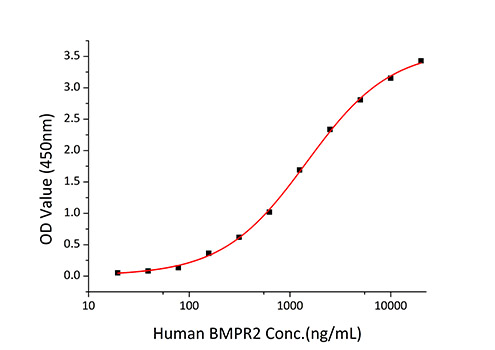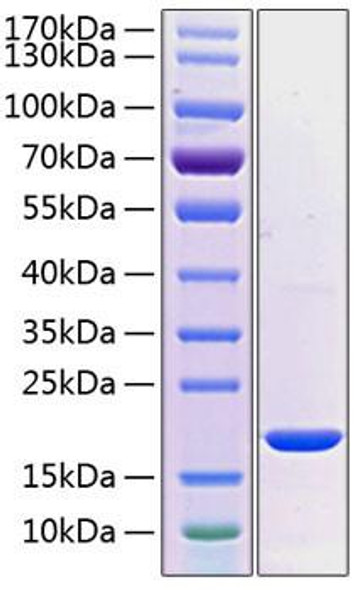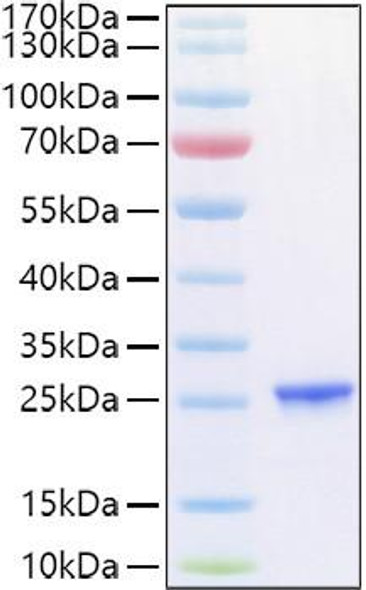Description
Recombinant Human BMPR-2 Protein
The Recombinant Human BMPR-2 Protein is a biologically active recombinant protein that plays a significant role in various cellular processes and signaling pathways in human biology. This protein is widely employed in immunological research, cell biology studies, protein-protein interaction analyses, and therapeutic development, providing researchers with a reliable tool for investigating BMPR-2 function and its implications in health and disease.
This product (SKU: RPCB1172) is produced using HEK293 cells and features a C-hFc tag for convenient detection and purification. The protein exhibits a calculated molecular weight of 39.97 kDa with an observed molecular weight of 55-70 kDa under denaturing conditions, achieving ≥ 95 % as determined by SDS-PAGE.. Functional bioactivity has been validated through rigorous quality control assays, confirming its suitability for demanding research applications.
Key Features
| High Purity by Affinity Chromatography | |
| Mammalian & Bacterial Expression Systems | |
| High lot-to-lot consistency via strict QC |
| Product Name: | Recombinant Human BMPR-2 Protein |
| SKU: | RPCB1172 |
| Size: | 10 μg , 20 μg , 50 μg , 100 μg |
| Reactivity: | Human |
| Synonyms: | BMPR2, BMPR-II, BMPR3, BMR2, BRK-3, POVD1, PPH1, T-ALK, bone morphogenetic protein receptor type-2, BMPR-II, BMPR3, BMR2, BRK-3, POVD1, PPH1, T-ALK |
| Tag: | C-hFc |
| Expression Host: | HEK293 cells |
| Calculated MW: | 39.97 kDa |
| Observed MW: | 55-70 kDa |
| Gene ID: | 659 |
| Protein Description: | High quality, high purity and low endotoxin recombinant Recombinant Human BMPR-2 Protein (RPCB1172), tested reactivity in HEK293 cells and has been validated in SDS-PAGE.100% guaranteed. |
| Endotoxin: | < 1 EU/μg of the protein by LAL method. |
| Purity: | ≥ 95 % as determined by SDS-PAGE. |
| Formulation: | Lyophilized from a 0.22 μm filtered solution of PBS, pH 7.4. |
| Bio-Activity: | Measured by its binding ability in a functional ELISA. Immobilized Human BMP2 at 1 μg/mL (100 μL/well) can bind Human BMPR2 with a linear range of 19.5 ng/ml-1.46 μg/ml. |
| Reconstitution: | Centrifuge the vial before opening. Reconstitute to a concentration of 0.1-0.5 mg/mL in sterile distilled water. Avoid vortex or vigorously pipetting the protein. For long term storage, it is recommended to add a carrier protein or stablizer (e.g. 0.1% BSA, 5% HSA, 10% FBS or 5% Trehalose), and aliquot the reconstituted protein solution to minimize free-thaw cycles. |
| Storage: | Store at -20℃.Store the lyophilized protein at -20℃ to -80 ℃ up to 1 year from the date of receipt. After reconstitution, the protein solution is stable at -20℃ for 3 months, at 2-8℃ for up to 1 week. |
The bone morphogenetic protein type II receptor (BMPR-II, or BMPR2), a receptor for the transforming growth factor (TGF)-beta/bone morphogenetic protein (BMP) superfamily. Reduced expression or function of BMPR2 signaling leads to exaggerated TGF-beta signaling and altered cellular responses to TGF-beta. In endothelial cells, BMPR2 mutation increases the susceptibility of cells to apoptosis. BMPR2 transduces BMP signals by forming heteromeric complexes with and phosphorylating BMP type I receptors. The intracellular domain of BMPR2 is both necessary and sufficient for receptor complex interaction. It had been identified that BMPR2 plays a key role in cell growth. Its mutations lead to hereditary pulmonary hypertension, and knockout of Bmpr-II results in early embryonic lethality. The C-terminal tail of BMPR2 provides binding sites for a number of regulatory proteins that may initiate Smad-independent signalling. BMPR2 mutations were predicted to alter the BMP and TGF-b1/SMAD signalling pathways, resulting in proliferation rather than apoptosis of vascular cells, and greatly increase the risk of developing severe pulmonary arterial hypertension. BMPR2 gene result in familial Primary pulmonary hypertension (PPH) transmitted as an autosomal dominant trait, albeit with low penetrance. Heterozygous germline mutations of BMPR2 gene have been identified in patients with familial and sporadic PPH, indicating that BMPR2 may contribute to the maintenance of normal pulmonary vascular structure and function. Tctex-1, a light chain of the motor complex dynein, interacts with the cytoplasmic domain of BMPR2 and demonstrate that Tctex-1 is phosphorylated by BMPR-II, a function disrupted by PPH disease causing mutations within exon 12. BMPR2 and Tctex-1 co-localize to endothelium and smooth muscle within the media of pulmonary arterioles, key sites of vascular remodelling in PPH.








